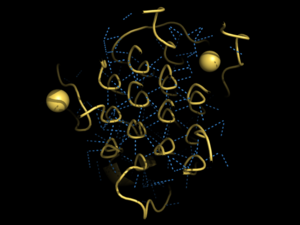Sandbox Reserved 1726
From Proteopedia
(Difference between revisions)
| Line 31: | Line 31: | ||
In ALK fusion proteins, the ALK fusion partner may cause dimerization independent of ligand binding, causing oncogenic ALK activation <ref name="Huang" />. | In ALK fusion proteins, the ALK fusion partner may cause dimerization independent of ligand binding, causing oncogenic ALK activation <ref name="Huang" />. | ||
The regulation of ALK dimerization by ALKAL points to clear ways to inhibit ALK activity and may offer new therapeutic strategies in multiple disease settings <ref name="Li">PMID:34819665</ref>. Studies have shown that approximately 70-80% of all patients who have Anaplastic Large Cell Lymphoma (ALCL) contain the genetic complex of the ALK gene and the nucleolar phosphoprotein B23, also called numatrin (NPM) gene translocation, creating the NPM-ALK complex. This chimeric protein is expressed from the NPM promoter, leading to the overexpression of the ALK catalytic domain. This overexpression of ALK is characteristic of most cancers that are linked to tyrosine kinases, as the overexpression of these proteins leads to uncontrollable growth <ref name="Della Corte">PMID:29455642</ref>. | The regulation of ALK dimerization by ALKAL points to clear ways to inhibit ALK activity and may offer new therapeutic strategies in multiple disease settings <ref name="Li">PMID:34819665</ref>. Studies have shown that approximately 70-80% of all patients who have Anaplastic Large Cell Lymphoma (ALCL) contain the genetic complex of the ALK gene and the nucleolar phosphoprotein B23, also called numatrin (NPM) gene translocation, creating the NPM-ALK complex. This chimeric protein is expressed from the NPM promoter, leading to the overexpression of the ALK catalytic domain. This overexpression of ALK is characteristic of most cancers that are linked to tyrosine kinases, as the overexpression of these proteins leads to uncontrollable growth <ref name="Della Corte">PMID:29455642</ref>. | ||
| - | === Neuroblastoma === | + | ==== Pediatric Neuroblastoma ==== |
| - | Mutations in Anaplastic Lymphoma Kinase have been shown to produce oncogenic activity and | + | Mutations in Anaplastic Lymphoma Kinase have been shown to produce oncogenic activity and be a leading factor in some pediatric neuroblastoma cases. 8-10% of primary [neuroblastoma] patients are ALK positive <ref name="Borenas" /> meaning that the overstimulation of the ALK is thought to be the primary factor in propagating the growth of neuroblastoma. This overstimulation of ALK works in concert with the neural MYC oncogene, and uses the ALKAL2 ligand in these specific cases. Its thought that tyrosine kinase inhibitors would be useful methods to stop the growth of further neuroblastoma cells, creating a potential pathway of treatment. <ref name="Borenas" /> |
| - | + | ||
</StructureSection> | </StructureSection> | ||
== References == | == References == | ||
<references/> | <references/> | ||
Revision as of 19:26, 31 March 2022
| This Sandbox is Reserved from February 28 through September 1, 2022 for use in the course CH462 Biochemistry II taught by R. Jeremy Johnson at the Butler University, Indianapolis, USA. This reservation includes Sandbox Reserved 1700 through Sandbox Reserved 1729. |
To get started:
More help: Help:Editing |
Anaplastic Lymphoma Kinase Extracellular Region
| |||||||||||
References
- ↑ 1.0 1.1 1.2 1.3 Huang H. Anaplastic Lymphoma Kinase (ALK) Receptor Tyrosine Kinase: A Catalytic Receptor with Many Faces. Int J Mol Sci. 2018 Nov 2;19(11). pii: ijms19113448. doi: 10.3390/ijms19113448. PMID:30400214 doi:http://dx.doi.org/10.3390/ijms19113448
- ↑ 2.0 2.1 Li T, Stayrook SE, Tsutsui Y, Zhang J, Wang Y, Li H, Proffitt A, Krimmer SG, Ahmed M, Belliveau O, Walker IX, Mudumbi KC, Suzuki Y, Lax I, Alvarado D, Lemmon MA, Schlessinger J, Klein DE. Structural basis for ligand reception by anaplastic lymphoma kinase. Nature. 2021 Dec;600(7887):148-152. doi: 10.1038/s41586-021-04141-7. Epub 2021, Nov 24. PMID:34819665 doi:http://dx.doi.org/10.1038/s41586-021-04141-7
- ↑ 3.0 3.1 3.2 3.3 Reshetnyak AV, Rossi P, Myasnikov AG, Sowaileh M, Mohanty J, Nourse A, Miller DJ, Lax I, Schlessinger J, Kalodimos CG. Mechanism for the activation of the anaplastic lymphoma kinase receptor. Nature. 2021 Dec;600(7887):153-157. doi: 10.1038/s41586-021-04140-8. Epub 2021, Nov 24. PMID:34819673 doi:http://dx.doi.org/10.1038/s41586-021-04140-8
- ↑ 4.0 4.1 4.2 Borenas M, Umapathy G, Lai WY, Lind DE, Witek B, Guan J, Mendoza-Garcia P, Masudi T, Claeys A, Chuang TP, El Wakil A, Arefin B, Fransson S, Koster J, Johansson M, Gaarder J, Van den Eynden J, Hallberg B, Palmer RH. ALK ligand ALKAL2 potentiates MYCN-driven neuroblastoma in the absence of ALK mutation. EMBO J. 2021 Feb 1;40(3):e105784. doi: 10.15252/embj.2020105784. Epub 2021 Jan 7. PMID:33411331 doi:http://dx.doi.org/10.15252/embj.2020105784
- ↑ 5.0 5.1 Della Corte CM, Viscardi G, Di Liello R, Fasano M, Martinelli E, Troiani T, Ciardiello F, Morgillo F. Role and targeting of anaplastic lymphoma kinase in cancer. Mol Cancer. 2018 Feb 19;17(1):30. doi: 10.1186/s12943-018-0776-2. PMID:29455642 doi:http://dx.doi.org/10.1186/s12943-018-0776-2


